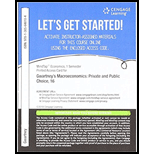
(a)
Identify the 2013 and 2014 real
(a)
Explanation of Solution
Table-1 shows the value of nominal GDP and the GDP deflator as follows:
| Table-1 | ||||
|
Nominal GDP (Billions of currency) |
GDP deflator (2010=100) | |||
| Country | 2013 | 2014 | 2013 | 2014 |
| U | 16,663.2 | 17,348.1 | 105.6 | 107.4 |
| C | 1,879.5 | 1,976.2 | 108.1 | 110.9 |
| J | 482,430 | 489,623 | 97.2 | 98.8 |
| I | 1,609.5 | 1,616.3 | 103.9 | 105 |
| A | 1,554.8 | 1,599.8 | 105.5 | 105.8 |
| UK | 1,713.1 | 1,791.5 | 104.3 | 106 |
The real GDP can be calculated using the formula as follows:
Use Equation-1 to calculate the real GDP of Country U in 2013 as follows:
Therefore, the real GDP of Country U in 2013 is $15,779.54 billion.
Table-2 shows the value of the real GDP in 2013 and 2014, which is calculated using Equation-1 as follows:
| Table-2 | ||||||
| Nominal GDP | GDP deflator | Real GDP | ||||
| Country | 2013 | 2014 | 2013 | 2014 | 2013 | 2014 |
| U | 16,663.2 | 17,348.1 | 105.6 | 107.4 | 15,779.5 | 16,152.8 |
| C | 1,879.5 | 1,976.2 | 108.1 | 110.9 | 1,738.67 | 1,781.97 |
| J | 482,430 | 489,623 | 97.2 | 98.8 | 496,327 | 495,570 |
| I | 1,609.5 | 1,616.3 | 103.9 | 105 | 1,549.09 | 1,539.33 |
| A | 1,554.8 | 1,599.8 | 105.5 | 105.8 | 1,473.74 | 1,512.10 |
| UK | 1,713.1 | 1,791.5 | 104.3 | 106 | 1,642.47 | 1,690.09 |
(b)
Identify the inflation rate in 2014.
(b)
Explanation of Solution
The inflation rate in 2014 can be calculated using the formula as follows:
Use Equation-2 to calculate the inflation rate of Country U in 2014 as follows:
Therefore, the inflation rate is 1.70%.
Table-3 shows the value of the inflation rate, which is calculated using Equation-2 as follows:
| Table-3 | |||||||
| Nominal GDP | GDP deflator | Real GDP | Inflation rate | ||||
| Country | 2013 | 2014 | 2013 | 2014 | 2013 | 2014 | 2014 |
| U | 16,663.2 | 17,348.1 | 105.6 | 107.4 | 15,779.5 | 16,152.8 | 1.70% |
| C | 1,879.5 | 1,976.2 | 108.1 | 110.9 | 1,738.67 | 1,781.97 | 2.59% |
| J | 482,430 | 489,623 | 97.2 | 98.8 | 496,327 | 495,570 | 1.65% |
| I | 1,609.5 | 1,616.3 | 103.9 | 105 | 1,549.09 | 1,539.33 | 1.06% |
| A | 1,554.8 | 1,599.8 | 105.5 | 105.8 | 1,473.74 | 1,512.1 | 0.28% |
| UK | 1,713.1 | 1,791.5 | 104.3 | 106 | 1,642.47 | 1,690.09 | 1.63% |
(c)
Identify the country that has the highest growth rate of real GDP.
(c)
Explanation of Solution
The growth rate can be calculated using the formula as follows:
Use Equatrion-3 to calculate the growth rate of real GDP as follows:
Therefore, the growth rate of real GDP is 2.36%.
Table-4 shows the growth rate in 2014, which is calculated using the Equation-3 as follows:
| Table-4 | ||||||||
| Nominal GDP | GDP deflator | Real GDP | Inflation rate | Growth rate | ||||
| Country | 2013 | 2014 | 2013 | 2014 | 2013 | 2014 | 2014 | 2014 |
| U | 16,663.2 | 17,348.1 | 105.6 | 107.4 | 15,779.5 | 16,152.8 | 1.70% | 2.37% |
| C | 1,879.5 | 1,976.2 | 108.1 | 110.9 | 1,738.67 | 1,781.97 | 2.59% | 2.49% |
| J | 482,430 | 489,623 | 97.2 | 98.8 | 496,327 | 495,570 | 1.65% | -0.15% |
| I | 1,609.5 | 1,616.3 | 103.9 | 105 | 1,549.09 | 1,539.33 | 1.06% | -0.63% |
| A | 1,554.8 | 1,599.8 | 105.5 | 105.8 | 1,473.74 | 1,512.1 | 0.28% | 2.60% |
| UK | 1,713.1 | 1,791.5 | 104.3 | 106 | 1,642.47 | 1,690.09 | 1.63% | 2.90% |
According to Table-4, Country UK has the highest growth rate of real GDP, which is 2.90% and Country J has the lowest growth rate of real GDP, which is -0.15%.
(d)
Identify the countries that have the highest and lowest inflation rate.
(d)
Explanation of Solution
According to Table-3, Country C has the highest inflation rate, which is 2.59% and Country A has the lowest inflation rate, which is 0.28%.
(e)
Identify the country that has the most inflation
(e)
Explanation of Solution
According to the data from Table-4, Country C has the highest inflation rate, which is 2.59%. Therefore, Country C has the most inflation during 2014.
Inflation: Inflation is a sustained rise in the price level of a selected basket of goods and service for a particular period.
Want to see more full solutions like this?
Chapter 8 Solutions
MindTap Economics, 1 term (6 months) Printed Access Card for Gwartney/Stroup/Sobel/Macpherson's Macroeconomics: Private and Public Choice, 16th (MindTap Course List)
- Sue is a sole proprietor of her own sewing business. Revenues are $150,000 per year and raw material (cloth, thread) costs are $130,000 per year. Sue pays herself a salary of $60,000 per year but gave up a job with a salary of $80,000 to run the business. ○ A. Her accounting profits are $0. Her economic profits are - $60,000. ○ B. Her accounting profits are $0. Her economic profits are - $40,000. ○ C. Her accounting profits are - $40,000. Her economic profits are - $60,000. ○ D. Her accounting profits are - $60,000. Her economic profits are -$40,000.arrow_forwardSelect a number that describes the type of firm organization indicated. Descriptions of Firm Organizations: 1. has one owner-manager who is personally responsible for all aspects of the business, including its debts 2. one type of partner takes part in managing the firm and is personally liable for the firm's actions and debts, and the other type of partner takes no part in the management of the firm and risks only the money that they have invested 3. owners are not personally responsible for anything that is done in the name of the firm 4. owned by the government but is usually under the direction of a more or less independent, state-appointed board 5. established with the explicit objective of providing goods or services but only in a manner that just covers its costs 6. has two or more joint owners, each of whom is personally responsible for all of the partnership's debts Type of Firm Organization a. limited partnership b. single proprietorship c. corporation Correct Numberarrow_forwardThe table below provides the total revenues and costs for a small landscaping company in a recent year. Total Revenues ($) 250,000 Total Costs ($) - wages and salaries 100,000 -risk-free return of 2% on owner's capital of $25,000 500 -interest on bank loan 1,000 - cost of supplies 27,000 - depreciation of capital equipment 8,000 - additional wages the owner could have earned in next best alternative 30,000 -risk premium of 4% on owner's capital of $25,000 1,000 The economic profits for this firm are ○ A. $83,000. B. $82,500. OC. $114,000. OD. $83,500. ○ E. $112,500.arrow_forward
- Output TFC ($) TVC ($) TC ($) (Q) 2 100 104 204 3 100 203 303 4 100 300 400 5 100 405 505 6 100 512 612 7 100 621 721 Given the information about short-run costs in the table above, we can conclude that the firm will minimize the average total cost of production when Q = (Round your response to the nearest whole number.)arrow_forwardThe following data show the total output for a firm when specified amounts of labour are combined with a fixed amount of capital. Assume that the wage per unit of labour is $20 and the cost of the capital is $100. Labour per unit of time 0 1 Total Output 0 25 T 2 3 4 5 75 137 212 267 The marginal product of labour is at its maximum when the firm changes the amount of labour hired from ○ A. 0 to 1 unit. ○ B. 3 to 4 units. OC. 2 to 3 units. OD. 1 to 2 units. ○ E. 4 to 5 units.arrow_forwardThe table below provides the annual revenues and costs for a family-owned firm producing catered meals. Total Revenues ($) 600,000 Total Costs ($) - wages and salaries 250,000 -risk-free return of 7% on owners' capital of $300,000 21,000 - rent 101,000 - depreciation of capital equipment 22,000 -risk premium of 9% on owners' capital of $300,000 27,000 - intermediate inputs 146,000 -forgone wages of owners in alternative employment -interest on bank loan 70,000 11,000 The implicit costs for this family-owned firm are ○ A. $70,000. OB. $97,000. OC. $589,000. OD. $118,000. ○ E. $48,000.arrow_forward
- Suppose a production function for a firm takes the following algebraic form: Q= 2KL - (0.3)L², where Q is the output of sweaters per day. Now suppose the firm is operating with 10 units of capital (K = 10) and 6 units of labour (L = 6). What is the output of sweaters? A. 64 sweaters per day OB. 49 sweaters per day OC. 109 sweaters per day OD. 72 sweaters per day OE. 118 sweaters per dayarrow_forward3. Consider a course allocation problem with strict and non-responsive preferences. Isthere a mechanism that is efficient and strategy-proof? If so, state the mechanismand show that it satisfies efficiency and strategyproofness. {hint serial dictatorship and show using example}4. Consider a course allocation problem with responsive preferences and at least 3students. Is there a mechanism that is efficient and strategy-proof that is not theSerial Dictatorship? If so, state the mechanism and show that it satisfies efficiencyand strategyproofness.5. Suggest a mechanism for allocating students to courses in a situation where preferences are non-responsive, and study its properties (efficiency and strategyproofness). Please be creativearrow_forward3. Consider a course allocation problem with strict and non-responsive preferences. Isthere a mechanism that is efficient and strategy-proof? If so, state the mechanismand show that it satisfies efficiency and strategyproofness. {hint serial dictatorship}4. Consider a course allocation problem with responsive preferences and at least 3students. Is there a mechanism that is efficient and strategy-proof that is not theSerial Dictatorship? If so, state the mechanism and show that it satisfies efficiencyand strategyproofness.5. Suggest a mechanism for allocating students to courses in a situation where preferences are non-responsive, and study its properties (efficiency and strategyproofness). Please be creativearrow_forward
 Macroeconomics: Private and Public Choice (MindTa...EconomicsISBN:9781305506756Author:James D. Gwartney, Richard L. Stroup, Russell S. Sobel, David A. MacphersonPublisher:Cengage Learning
Macroeconomics: Private and Public Choice (MindTa...EconomicsISBN:9781305506756Author:James D. Gwartney, Richard L. Stroup, Russell S. Sobel, David A. MacphersonPublisher:Cengage Learning Economics: Private and Public Choice (MindTap Cou...EconomicsISBN:9781305506725Author:James D. Gwartney, Richard L. Stroup, Russell S. Sobel, David A. MacphersonPublisher:Cengage Learning
Economics: Private and Public Choice (MindTap Cou...EconomicsISBN:9781305506725Author:James D. Gwartney, Richard L. Stroup, Russell S. Sobel, David A. MacphersonPublisher:Cengage Learning Economics (MindTap Course List)EconomicsISBN:9781337617383Author:Roger A. ArnoldPublisher:Cengage Learning
Economics (MindTap Course List)EconomicsISBN:9781337617383Author:Roger A. ArnoldPublisher:Cengage Learning
 Economics Today and Tomorrow, Student EditionEconomicsISBN:9780078747663Author:McGraw-HillPublisher:Glencoe/McGraw-Hill School Pub Co
Economics Today and Tomorrow, Student EditionEconomicsISBN:9780078747663Author:McGraw-HillPublisher:Glencoe/McGraw-Hill School Pub Co Macroeconomics: Principles and Policy (MindTap Co...EconomicsISBN:9781305280601Author:William J. Baumol, Alan S. BlinderPublisher:Cengage Learning
Macroeconomics: Principles and Policy (MindTap Co...EconomicsISBN:9781305280601Author:William J. Baumol, Alan S. BlinderPublisher:Cengage Learning





